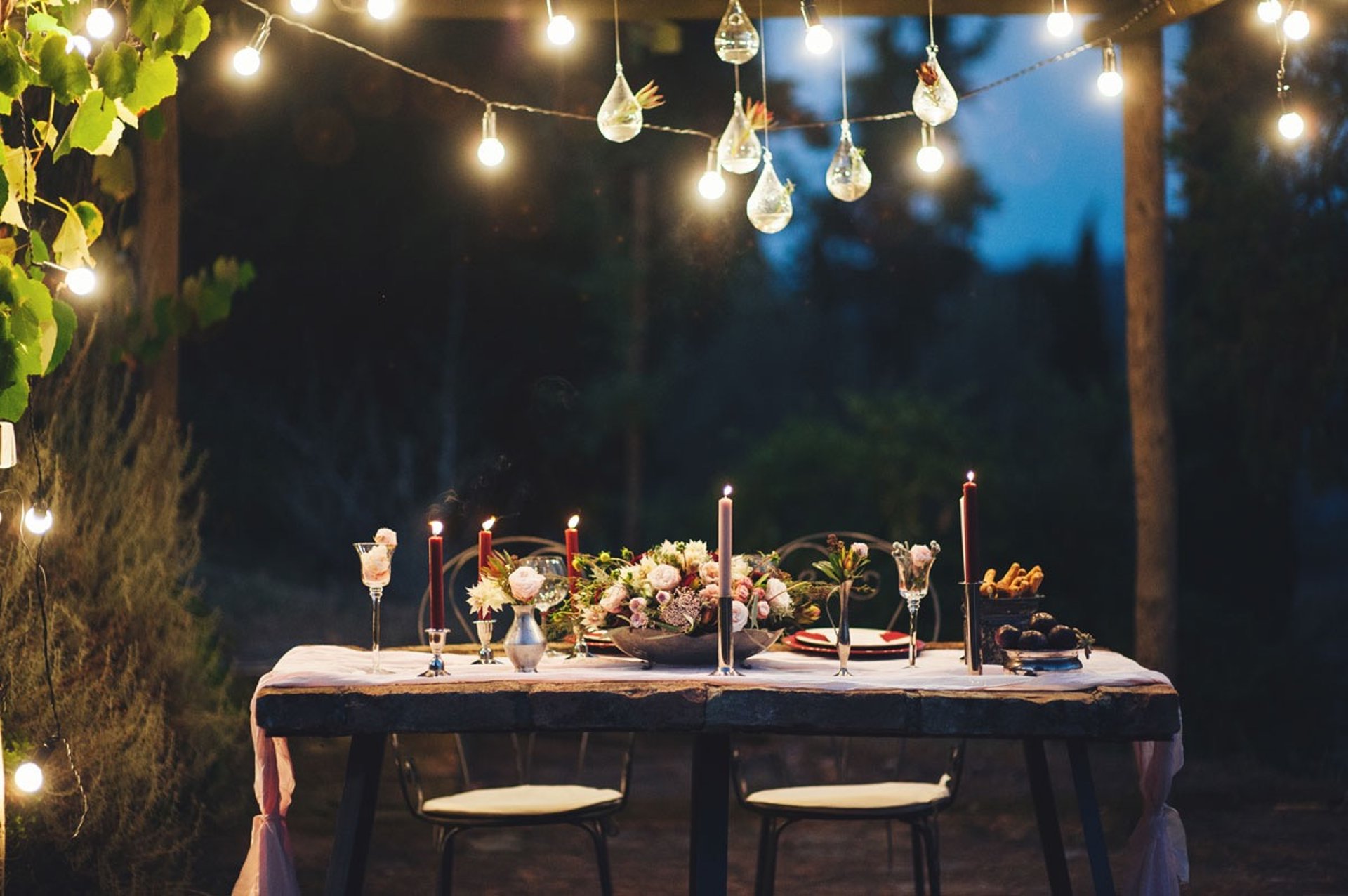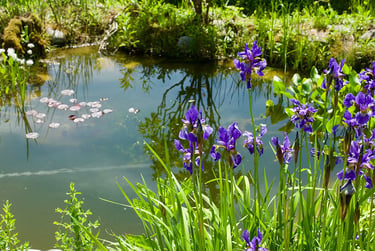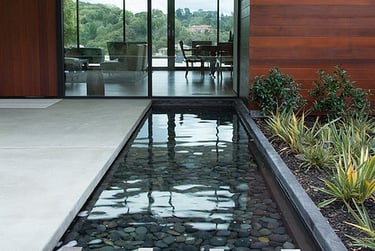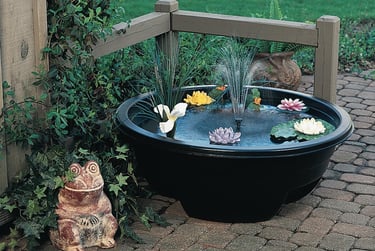
Designing a Serene Backyard Pond: How to Plan and Build a Peaceful Pond That Attracts Wildlife and Soothes the Mind
Create a backyard sanctuary that nourishes both wildlife and your wellbeing. This guide walks you through designing and building a serene backyard pond — from planning and placement to choosing plants, fish, and eco-friendly filtration systems that make your outdoor space a peaceful retreat.
WATER FEATURES
P & P
10/8/20255 min read


Designing a Serene Backyard Pond: How to Plan and Build a Peaceful Pond That Attracts Wildlife and Soothes the Mind
Disclosure: Papaver and Petals is a participant in the Amazon Services LLC Associates Program, an affiliate advertising program designed to provide a means for sites to earn fees by linking to Amazon.com and affiliated sites. As an Amazon Associate, we earn from qualifying purchases at no extra cost to you.
Introduction
There’s something deeply calming about the gentle sound of trickling water. A backyard pond transforms even a modest outdoor space into a sanctuary — one that supports wildlife, cools the surrounding air, and provides a tranquil focal point for rest and reflection.
Designing a serene pond is less about grandeur and more about balance. With thoughtful planning, the right materials, and a touch of creativity, you can create an environment that looks natural, functions sustainably, and becomes the heart of your garden.
1. Planning Your Pond: Finding the Right Spot
Before digging, take time to observe your yard’s light, slope, and drainage. The best pond locations usually meet these criteria:
Partial sunlight – Aim for 4–6 hours of sunlight daily to support aquatic plants without encouraging excessive algae growth.
Gentle slope – Ideal for natural runoff and drainage control.
Away from trees – Reduces leaf litter and root interference.
Visible from key outdoor areas – A pond is not just an ecosystem — it’s a visual centerpiece.
Sketch your layout on paper before starting. Consider the pond’s shape and scale in relation to your garden — soft, organic curves tend to blend more naturally than rigid lines.
Use biodegradable marking paint (Rust-Oleum 1988830 Specialty Marking Spray Paint - https://amzn.to/3K9J625) or a garden hose to visualize your pond’s shape before committing to excavation.
2. Choosing a Pond Style That Fits Your Space
Your pond’s style should complement the overall character of your garden:
Naturalistic Pond – Mimics a wild water feature with irregular edges, native aquatic plants, and stones. Perfect for wildlife and a relaxed setting.
Formal Reflecting Pond – Clean lines, symmetry, and still water for a minimalist, meditative aesthetic.
Container or Patio Pond – For small spaces, a ceramic bowl or whiskey barrel can hold aquatic plants and mini fountains.
Whichever design you choose, the goal is harmony — a pond that feels like it belongs, seamlessly integrated with the surrounding landscape.
3. Constructing the Pond: Step-by-Step Essentials
Once your design is set, it’s time to bring it to life.
Step 1: Excavate the Site
Mark your pond’s outline and dig to a depth of 18–24 inches for small ponds, or up to 36 inches for fish. Create shelves at varying depths for aquatic plants and easy wildlife access.
Step 2: Line the Pond
Lay down a protective underlayment followed by a flexible EPDM liner. Smooth it out, leaving some overhang for securing with stones or edging.
Lifeguard 10 ft. x 15 ft. EPDM Pond Liner – 45-Mil Rubber Liner - https://amzn.to/47Re2xb
Step 3: Add Water and Check Levels
Slowly fill the pond, adjusting the liner to remove wrinkles. Ensure the water line sits evenly all around.
Step 4: Add Rocks and Edging
Use natural river stones, flagstone, or driftwood to conceal the liner edges. This not only looks organic but provides shelter for frogs, insects, and small birds.
Step 5: Install a Pump and Filter
A low-voltage pump ensures water circulation, keeping it clear and oxygenated. Pair with a biological filter to support beneficial bacteria that maintain water quality.
Pond Filter with Pump Fountain Kits, 660GPH Pond Filter with 40W Pond Pump & Fountain Kit - https://amzn.to/49qKIPh
4. Bringing It to Life: Plants and Wildlife
A pond comes alive when plants and wildlife move in. Select a mix of aquatic and marginal plants to balance aesthetics and ecology.
Aquatic Plants (Oxygenators)
Anacharis or Hornwort – Keep water clear and oxygen-rich.
Oxygenating Hornwort Coontail Ceratophyllum Demersum - https://amzn.to/4riBBXt
Water lilies – Provide shade and help control algae.
Nymphaea Wanvisa Red Hardy Water Lily 1 Rhizome - https://amzn.to/4o5fCQM
Lotus – Adds elegance and structure to deeper ponds.
Tiger Lotus Bulb Red - https://amzn.to/4o6fjoY
Marginal Plants (Edge Stabilizers)
Iris, Pickerelweed, and Cattails – Thrive at pond edges and offer nesting material for birds.
Creeping Jenny or Marsh marigold – Perfect for softening rock edges.
Wildlife Considerations
Your pond will naturally attract frogs, dragonflies, and songbirds. Avoid using chemicals or chlorinated water, which can harm beneficial species. If you’d like to include fish, goldfish or koi are classic choices — just ensure your pond depth and filtration can support them year-round.
5. Creating Serenity Through Design Details
To make your pond a place of relaxation and reflection:
Add a small waterfall or fountain for gentle sound and movement.
Surround it with seating — a bench or natural stone perch for meditation or morning coffee.
Include path lighting or solar lanterns to highlight the water’s shimmer at dusk.
Plant fragrant herbs like lavender or mint nearby for a sensory experience.
Look for solar-powered pond pumps or LED lights to reduce energy use while enhancing ambiance.
6. Maintenance for a Healthy, Balanced Pond
Simplicity is key. A well-designed pond largely maintains itself, but a few habits will keep it thriving:
Skim debris regularly to prevent decay.
Trim overgrown plants to maintain oxygen balance.
Top off water lost to evaporation with rainwater if possible.
Clean filters every few weeks during the growing season.
Winter care: If you live in a colder climate, install a pond de-icer to prevent freezing completely — essential for fish survival.
TURBRO Pond De-icer - https://amzn.to/4ppMSn5
Over time, your pond will find its equilibrium, attracting beneficial organisms that keep the water clear and the environment self-sustaining.
7. Designing for Mindfulness and Connection
A serene pond isn’t just about aesthetics — it’s an invitation to slow down. The reflective surface, gentle sounds, and natural visitors all encourage moments of stillness.
Consider adding a small bridge, stepping stones, or meditation platform nearby. These design elements turn your pond into more than a garden feature — they create an outdoor refuge that nurtures both you and the local ecosystem.
Conclusion
A backyard pond is a living reflection of balance — between water and land, structure and spontaneity, design and nature. When crafted thoughtfully, it becomes a sanctuary for wildlife and a retreat for the human spirit.
With patience, planning, and the right tools, you can create a pond that soothes the senses, enriches the landscape, and transforms your garden into a true haven of peace.






